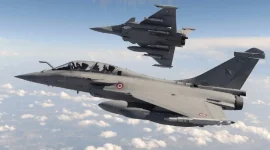- Views: 886
- Replies: 11
Hindustan Aeronautics Limited (HAL), the cornerstone of India's indigenous military aviation industry, is facing a severe workforce shortage that poses a direct threat to its production schedules for critical national defence projects.
According to an assessment by a former senior official, the state-owned enterprise's employee numbers have been cut in half over the years, even as its project pipeline has expanded with complex and high-priority platforms.
This growing gap between manpower and workload is placing immense strain on the company's technical staff and raising serious questions about its management strategies.
The scale of the manpower crisis is stark when set against HAL's expanding commitments. The company holds a robust order book valued at over ₹94,000 crore as of March 2024, yet it is operating with a significantly diminished workforce.
G. Syam Nath, a former Executive Director at HAL, highlighted that junior and mid-level employees are dangerously overstretched. This has led to widespread fatigue and declining morale, creating an environment where HAL may struggle to meet its contractual obligations for crucial military hardware.
This staffing shortfall could directly impact the timelines of India's most prestigious aviation programs.
HAL is responsible for ramping up production of the Tejas Mk-1A fighter jet, with a target of delivering 83 units to the Indian Air Force. Furthermore, it plays a central role in the development of the Advanced Medium Combat Aircraft (AMCA), India’s ambitious fifth-generation stealth fighter.
Experts warn that without adequate staffing, these vital programs could face significant delays, cost overruns, and potential compromises in quality, undermining India's efforts towards self-reliance in defence.
Compounding the problem is a perception that HAL's management has been slow to adopt modern, employee-centric policies that could improve retention and productivity. Initiatives such as flexible work hours or a five-day workweek, which are standard in many modern corporations, have not been implemented.
Mr. Nath pointed out that while the company conducts internal surveys on employee satisfaction, the results and any subsequent actions are not shared transparently, which has weakened trust between the workforce and senior leadership.
Financially, the solution appears well within reach. According to Mr. Nath's analysis, the cost of hiring a new entry-level engineer is less than ₹10 lakh per year. A significant recruitment drive to hire over 1,000 engineers would add approximately ₹120 crore to the company's annual expenses. This represents just 0.6% of HAL's total costs of ₹19,919 crore in the last financial year.
Given that HAL reported record revenues and profitability, such an investment in its workforce would be negligible to its bottom line. The data suggests that aggressive hiring is not only affordable but essential for the company's operational stability and future growth.



